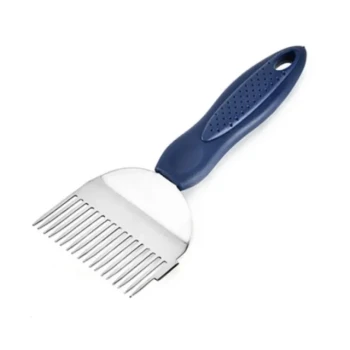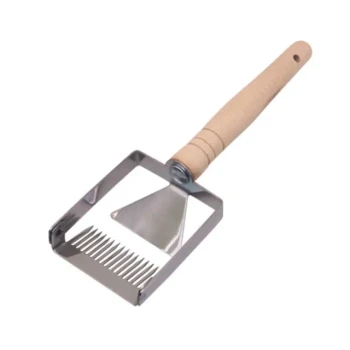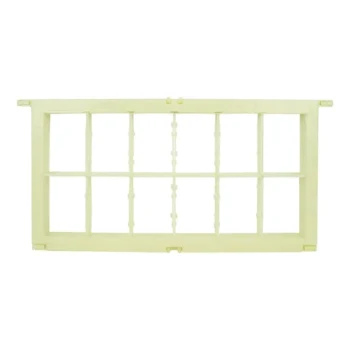At its core, feeding a top bar hive (TBH) is an internal process. Unlike vertically stacked hives, feeders are placed inside the main hive body, typically in a dedicated space at the back of the hive created by a movable wall called a follower board. The most common methods involve an upside-down jar for liquid feed or a block of fondant for solid winter feed, both of which are kept separate from the colony's living area.
The horizontal design of a top bar hive dictates its feeding strategy. Because you cannot stack equipment on top, feeding is managed within the hive cavity, using a follower board to create a protected, accessible feeding station without disturbing the colony.
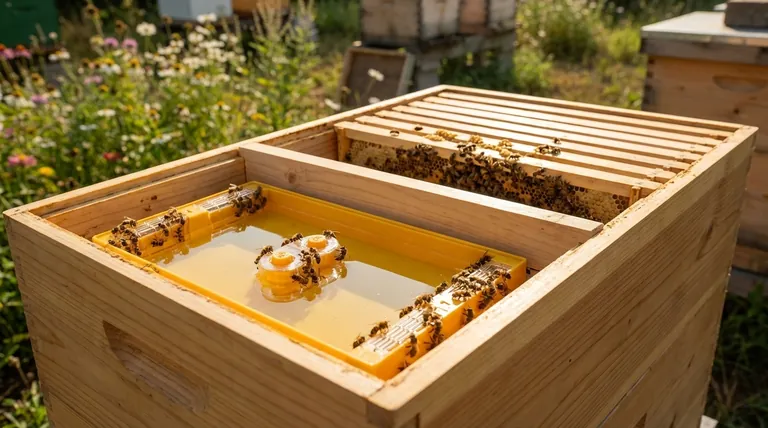
The Core Principle: Managing Space Internally
The entire philosophy of top bar hive management revolves around its long, horizontal structure. This design directly influences how you provide supplemental food.
The Horizontal Layout
A top bar hive is essentially a long trough covered by individual bars. Bees build their comb downwards from these bars.
This horizontal layout means you cannot simply place a feeder on top of the hive box as you would with a multi-story Langstroth hive. All manipulations, including feeding, happen along this horizontal axis.
The Role of the Follower Board
The follower board is the key component that makes internal feeding possible. It's a solid partition, shaped like the hive's cross-section, that functions as a movable internal wall.
Beekeepers use it to expand or contract the space available to the colony. For feeding, you place the follower board to wall off the bees, creating an empty, protected cavity at one end of the hive. This becomes your feeding chamber.
How a Feeder is Installed
The process is straightforward and minimally disruptive. You slide the top bars back from the unoccupied end of the hive, place your feeder into the empty space behind the follower board, and then replace the bars and the roof.
The bees can access the feed through a small gap or by going over or around the follower board, but the feeder itself remains isolated from the brood nest.
Common Feeder Types for Top Bar Hives
The choice of feeder depends entirely on the season and your goal.
Liquid Feeders for Stimulation
For providing sugar syrup in spring or during a nectar shortage, the most common method is an upside-down jar.
A standard mason jar is filled with syrup, and the lid is pierced with a few small holes. The jar is placed lid-down inside the feeding chamber. The vacuum pressure prevents the syrup from pouring out, allowing bees to drink from the drips.
Solid Feeders for Winter
During winter, adding moisture to the hive can be dangerous for the colony. For this reason, beekeepers use solid feed like fondant or a "sugar cake."
This solid block of sugar is placed in the feeding chamber. The bees will consume it as needed throughout the winter, providing them with critical energy reserves without the risks associated with liquid feed in cold weather.
Understanding the Trade-offs
Internal feeding has distinct advantages and disadvantages compared to other methods.
Pro: Reduced Robbing
Because the feeder is located inside the hive, it is significantly less likely to attract bees from other colonies. This dramatically reduces the risk of "robbing," where a stronger colony attacks a weaker one to steal its food stores.
Pro: Minimal Disturbance
You can often check and refill the feeder by only opening the very back of the hive. This allows you to feed the colony without exposing the sensitive brood nest to cold air or disrupting the queen.
Con: Limited Capacity
The space behind the follower board is finite. You cannot use the very large, multi-gallon feeders available for Langstroth hives. This means you may need to refill the feeder more frequently during periods of high demand.
Con: Potential for Drowning
With any liquid feeder, there is a risk of bees getting into the feeding chamber and drowning in the syrup. This can be mitigated by adding floats (like wood chips or corks) to the syrup if you use an open container, though the jar method is generally safer.
Making the Right Choice for Your Goal
Your feeding strategy should always be intentional and aligned with the colony's needs.
- If your primary focus is stimulating spring growth: Use a liquid syrup feeder (1:1 sugar to water) to mimic a natural nectar flow and encourage the queen to lay eggs.
- If your primary focus is emergency feeding during summer: Use a liquid syrup feeder (1:1 or 2:1 sugar to water) to prevent the colony from starving during a nectar dearth.
- If your primary focus is ensuring winter survival: Use a solid fondant or sugar cake feeder behind the follower board to provide energy without adding excess moisture to the hive.
By understanding how to use the follower board, you can effectively manage your colony's nutrition in a way that aligns perfectly with the simple, natural design of the top bar hive.
Summary Table:
| Feeder Type | Best Use Case | Key Advantage |
|---|---|---|
| Upside-Down Jar | Spring Stimulation / Summer Emergency | Mimics nectar flow, encourages brood rearing |
| Solid Fondant Block | Winter Survival | Provides energy without adding dangerous moisture |
Ready to equip your apiary with the right feeding supplies? HONESTBEE specializes in wholesale beekeeping equipment for commercial apiaries and distributors. Our durable, purpose-built supplies help you manage colonies efficiently, from spring stimulation to winter survival. Contact our team today to discuss your needs and request our wholesale catalog.
Visual Guide
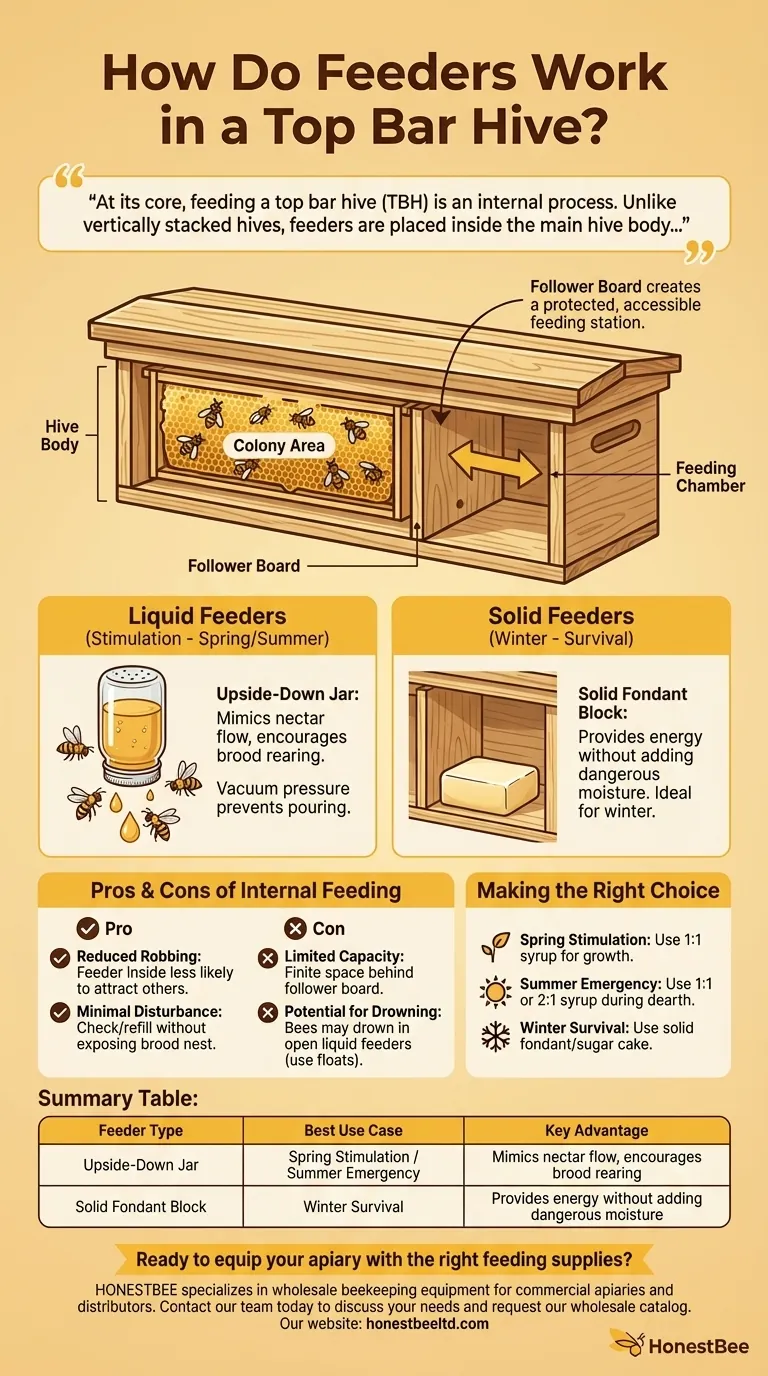
Related Products
- Professional Hive Top Bee Feeder for Beekeeping
- Boardman Entrance Bee Feeder Durable Galvanized Steel and Wood Construction for Beekeeping
- Professional Hive Front Entrance Bee Feeder
- Classic Boardman Entrance Bee Feeder Hive Front Feeding Solution
- Long Langstroth Style Horizontal Top Bar Hive for Wholesale
People Also Ask
- What types of hive boxes is the round hive top feeder compatible with? Universal Fit for 8 & 10-Frame Langstroth Hives
- Do I need an inner cover with a hive top feeder? Optimize Your Hive Setup for Healthy Bees
- Why is a top feeder essential for bees? Ensure Colony Health and Efficiency
- What are the advantages of hive top feeders? Maximize Feeding Efficiency for Your Apiary
- What is a top feeder for bees? Maximize Colony Health with Efficient Feeding














